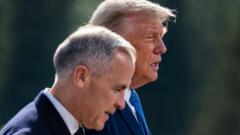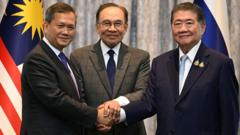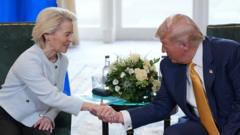A clandestine meeting with a Los Angeles fentanyl dealer in Mexico exposes the extensive network fueling America’s opioid epidemic. Despite President Trump's tariffs and promised crackdowns, demand remains high, with cartels evolving and adapting. The fentanyl crisis, now exacerbated by the synthetic opioid's potency, is unyielding as American communities grapple with an alarming rise in overdose deaths.
Tracking the Deadly Fentanyl Trade: A Journey from Mexican Cartels to U.S. Streets

Tracking the Deadly Fentanyl Trade: A Journey from Mexican Cartels to U.S. Streets
BBC's investigation reveals the dark realities of fentanyl trafficking, its impact on communities, and the ongoing battle against the opioid crisis.
Article Text:
In a meticulous operation, a fentanyl dealer from Los Angeles observes as a Mexican drug cartel operative readies the latest shipment of the potent synthetic opioid. Wrapped securely in foil and sealed with care, the drugs are submerged into the gas tank of a seemingly ordinary vehicle at a cartel stronghold in Mexico. Operating within the shadows of this nondescript neighborhood, the cartel members strain to maintain secrecy and avoid detection.
This surreptitious trade remains central to a significant geopolitical standoff as it underpins the rationale for increased tariff impositions by the White House. Fighting back against fentanyl smuggling has been a cornerstone of President Donald Trump's strategy, who has pledged to combat the drug trafficking networks aggressively. The BBC’s investigation reveals the stark realities of these operations on both sides of the border, as the flow of narcotics into the U.S. continues unabated.
Inside the safe house, the operatives—some masked and reserved—demonstrate their trade process, suggesting fleeting moments of guilt intermingled with a profound acceptance of their roles in the drug epidemic. As one operative quips, “If I stop, it’s going to continue. It’s not my problem,” showcasing a chilling detachment from the consequences of their actions.
Describing his business, “Jay” (a pseudonym for the dealer) elaborates that he manages to push tens of thousands of pills weekly into the U.S., exploiting the constant demand. The market dynamics are clear: the price of fentanyl pills has significantly dropped, alluding to the oversupply that has engulfed the American market.
Recent policies in the U.S. have attempted to stem this tide, with tariffs introduced as a mechanism to counteract illicit drug imports. However, the execution of these measures has seen substantial delays, and Jay expresses skepticism about the effectiveness of such tariffs in combating the entrenched threat posed by fentanyl.
Fentanyl’s rise to prominence in the drug trade is attributed to its production ease and potency—50 times stronger than traditional heroin—which leads to a higher addiction rate and vast health ramifications. As U.S. overdose fatalities hover uncomfortably high, with nearly 87,000 reported, both governments grapple with the complexities of an international drug crisis which has roots extending back to the opioid prescription practices of the late 1990s.
Meanwhile, Mexican President Claudia Sheinbaum's proactive stance coincides with concerted efforts to quell cartel operations, deploying thousands of National Guard troops to bolster border security, resulting in numerous arrests and significant drug seizures. The criminal networks, however, adapt swiftly; restricting key ingredients from China has led cartels to slightly dilute their products while still managing to supply the relentless appetite in the U.S.
As drug enforcement agencies ramp up their operations, the broader issue of demand in America remains unaddressed. Derek Maltz, interim DEA leader, points out the dual challenge of confronting these transnational cartels while acknowledging the root causes of addiction among U.S. citizens.
In the heart of Kensington—one of America’s most notorious open-air drug markets—community figures like Rosalind Pichardo fight back against the ravages of addiction. Documenting her efforts in reversing overdoses with Narcan, her experiences reflect the urgent need for compassion and understanding toward a growing population ensnared by drugs. Amid recounting countless interventions, Pichardo stresses that despite the overarching drug war, solutions are elusive, as new narcotics rise to meet the demand when old ones are cut off.
Across this narrative thread lies a stark reality: as the U.S. grapples with policy measures against the backdrop of growing drug availability, the cycle of addiction and detoxification continues unabated, leaving communities torn as they navigate the line between survival and suffering in the face of a grim epidemic.
In a meticulous operation, a fentanyl dealer from Los Angeles observes as a Mexican drug cartel operative readies the latest shipment of the potent synthetic opioid. Wrapped securely in foil and sealed with care, the drugs are submerged into the gas tank of a seemingly ordinary vehicle at a cartel stronghold in Mexico. Operating within the shadows of this nondescript neighborhood, the cartel members strain to maintain secrecy and avoid detection.
This surreptitious trade remains central to a significant geopolitical standoff as it underpins the rationale for increased tariff impositions by the White House. Fighting back against fentanyl smuggling has been a cornerstone of President Donald Trump's strategy, who has pledged to combat the drug trafficking networks aggressively. The BBC’s investigation reveals the stark realities of these operations on both sides of the border, as the flow of narcotics into the U.S. continues unabated.
Inside the safe house, the operatives—some masked and reserved—demonstrate their trade process, suggesting fleeting moments of guilt intermingled with a profound acceptance of their roles in the drug epidemic. As one operative quips, “If I stop, it’s going to continue. It’s not my problem,” showcasing a chilling detachment from the consequences of their actions.
Describing his business, “Jay” (a pseudonym for the dealer) elaborates that he manages to push tens of thousands of pills weekly into the U.S., exploiting the constant demand. The market dynamics are clear: the price of fentanyl pills has significantly dropped, alluding to the oversupply that has engulfed the American market.
Recent policies in the U.S. have attempted to stem this tide, with tariffs introduced as a mechanism to counteract illicit drug imports. However, the execution of these measures has seen substantial delays, and Jay expresses skepticism about the effectiveness of such tariffs in combating the entrenched threat posed by fentanyl.
Fentanyl’s rise to prominence in the drug trade is attributed to its production ease and potency—50 times stronger than traditional heroin—which leads to a higher addiction rate and vast health ramifications. As U.S. overdose fatalities hover uncomfortably high, with nearly 87,000 reported, both governments grapple with the complexities of an international drug crisis which has roots extending back to the opioid prescription practices of the late 1990s.
Meanwhile, Mexican President Claudia Sheinbaum's proactive stance coincides with concerted efforts to quell cartel operations, deploying thousands of National Guard troops to bolster border security, resulting in numerous arrests and significant drug seizures. The criminal networks, however, adapt swiftly; restricting key ingredients from China has led cartels to slightly dilute their products while still managing to supply the relentless appetite in the U.S.
As drug enforcement agencies ramp up their operations, the broader issue of demand in America remains unaddressed. Derek Maltz, interim DEA leader, points out the dual challenge of confronting these transnational cartels while acknowledging the root causes of addiction among U.S. citizens.
In the heart of Kensington—one of America’s most notorious open-air drug markets—community figures like Rosalind Pichardo fight back against the ravages of addiction. Documenting her efforts in reversing overdoses with Narcan, her experiences reflect the urgent need for compassion and understanding toward a growing population ensnared by drugs. Amid recounting countless interventions, Pichardo stresses that despite the overarching drug war, solutions are elusive, as new narcotics rise to meet the demand when old ones are cut off.
Across this narrative thread lies a stark reality: as the U.S. grapples with policy measures against the backdrop of growing drug availability, the cycle of addiction and detoxification continues unabated, leaving communities torn as they navigate the line between survival and suffering in the face of a grim epidemic.





















